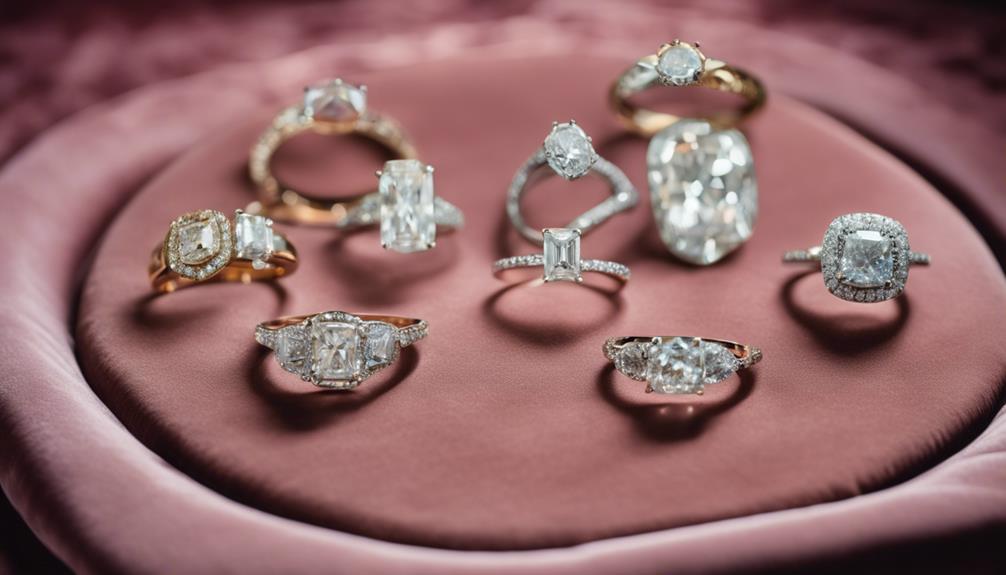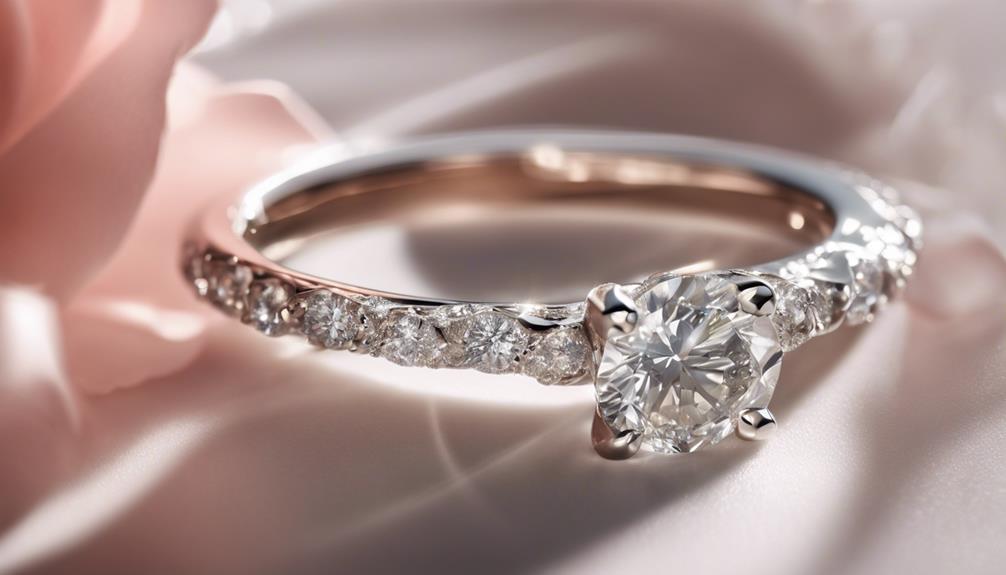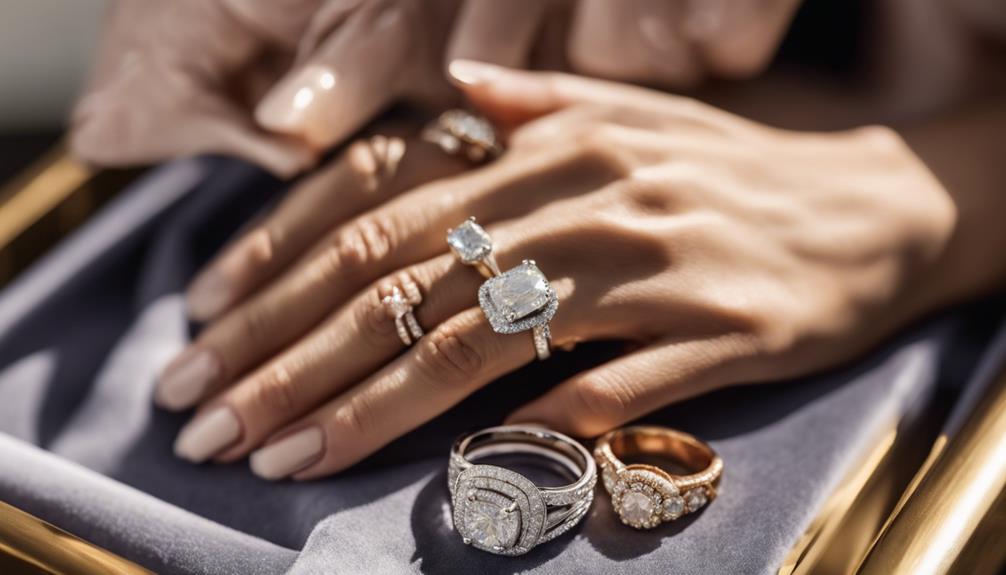Choosing the right engagement ring size involves more than just picking a carat weight. Consider personal taste, lifestyle, and budget. The average in the U.S. is 1.7 carats, but preferences vary. Younger buyers often opt for smaller stones, while older buyers might choose larger ones. Lifestyle matters too—active individuals may need a durable setting. Don’t forget to explore budget-friendly options like lab-grown diamonds or a halo setting, which adds visual impact. Shapes like oval or pear can also make the stone appear larger. There’s much more to discover on finding the perfect fit for you and your partner.
Understanding Carat Size

When it comes to understanding carat size, it’s essential to grasp that carat refers to the diamond’s weight, not its size alone. This distinction is important when selecting the perfect engagement ring size. The average carat size for diamond engagements in the U.S. is about 1.7 carats, with half of all rings falling between 1 and 2 carats. Knowing this average helps you gauge where most people stand and can guide you in choosing the right carat weight for your ring.
Different factors, like age and financial status, impact preferences. Younger buyers, typically in their 20s and early 30s, often select diamonds between 1 to 2 carats. Meanwhile, older individuals with more financial flexibility might opt for larger stones.
Regional differences also play a role; for instance, in affluent cities like NYC, the average carat size is around 2.5 carats, whereas smaller cities might lean towards 0.5 to 0.7 carats.
To optimize visuals and cost, consider buying a diamond just under a whole carat. Diamonds weighing 0.9 to 0.99 carats can appear substantial while offering savings, helping you choose the right balance for your dream engagement ring.
Factors Influencing Size Choice
Understanding carat size sets the stage for considering other factors that influence your engagement ring choice. While the average engagement ring size for women ranges between 6 to 7, various elements should guide your decision. Here’s what you should keep in mind:
- Age: Younger buyers often go for smaller diamonds, typically between 0.5 to 1 carat. In contrast, older clients might lean towards larger stones, often 1.5 carats or more. As you age, your preferences may evolve, impacting your choice.
- Lifestyle Factors: If you enjoy an active lifestyle, consider a ring that’s practical and durable. A smaller, secure setting can minimize the risk of damage while maintaining elegance.
- Cultural Differences: Societal norms and regional customs can shape size preferences. In some cultures, a ring between 1 and 2 carats might be deemed traditional and respectable. Explore what’s customary in your area or cultural background to help you decide.
- Personal Choice: Ultimately, your engagement ring should reflect your personal taste and story. Consider factors like finger shape, dominant hand size, and your unique style. Your ring should feel comfortable and meaningful to you.
Balancing these factors will help you find the perfect ring that complements your life and love story.
Average Engagement Ring Sizes

In the domain of engagement rings, the average size in the U.S. currently stands at about 1.7 carats. This figure has risen by 8% from the previous year, showing a trend toward larger stones.
If you’re considering diamond size, it’s helpful to know that approximately 50% of engagement rings sold are between 1 and 2 carats. This range seems to strike a balance for many couples seeking a blend of visual impact and practicality.
Interestingly, the average size of natural diamonds in engagement rings has increased to 1.6 carats, up from 1.5 carats in 2022. This increase hints at a growing preference for slightly larger stones.
Lab-grown diamonds, which offer a more budget-friendly option, also average around 1.5 to 1.6 carats. This consistency in diamond size preferences suggests that whether natural or lab-grown, many couples are opting for similar visual impact.
As you evaluate engagement rings, remember that the average carat size might guide your choice, but it shouldn’t define it.
Consider factors like personal taste and lifestyle alongside these averages. After all, the perfect ring is a reflection of your unique love story.
Budget-Friendly Size Tips
For those looking to maximize the size of their engagement ring while sticking to a budget, strategic choices can make a big difference. You don’t have to break the bank to find an impressive ring. By considering a few clever options, you’ll be surprised at how much carat size for engagement you can afford.
- Choose Slightly Under Common Carat Weights: Opt for diamonds that are just below full carat marks, like 0.90 to 0.99 carats. These stones often look nearly identical to a full carat but come at a more budget-friendly price.
- Explore Lab-Grown Diamonds: These are typically 20-40% cheaper than natural ones, allowing you to get a bigger diamond for your budget, enhancing the overall diamond looks without compromising on quality.
- Consider a Halo Setting: Surrounding your center stone with smaller diamonds can make it appear larger. This setting enhances the size for an engagement ring without the cost of a larger center stone.
- Adjust the Cut and Clarity: Choose cuts like the emerald cut, which can make a diamond look larger. Lower clarity grades can also save money while still offering a stunning appearance.
Maximizing Diamond Appearance

To achieve the best look for your engagement ring without exceeding your budget, focus on maximizing the diamond’s appearance.
Start by considering the carat size and the diamond shape. An emerald cut diamond creates an illusion of being larger than a round diamond of the same weight. Similarly, oval and pear-shaped diamonds appear bigger due to their elongated forms, giving you more visual impact without increasing the carat size.
Incorporating a halo setting can greatly enhance the perceived size of your diamond. A halo of smaller diamonds encircling the center stone not only adds sparkle but also makes the main diamond look larger. This is a cost-effective way to boost the ring’s appearance without shelling out for a higher carat weight.
Choosing a diamond with a slightly lower carat size, like 0.9 to 0.99 carats, can save you money while maintaining a substantial look.
Also, opt for a light color grade such as G, H, or I. These grades can give your diamond a colorless appearance, maximizing its visual appeal without the high cost of more premium color grades.
Conclusion
When choosing an engagement ring, focus on what truly matters to you and your partner. Don’t get too caught up in carat size alone; consider how the ring aligns with your shared style and budget. Remember, the perfect ring isn’t about meeting an average—it’s about reflecting your unique love story. By prioritizing what resonates with your hearts, you’ll select a ring that’s not just beautiful, but also deeply meaningful and cherished forever.



